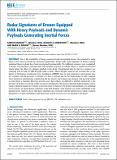Files in this item
Radar signatures of drones equipped with heavy payloads and dynamic payloads generating inertial forces
Item metadata
| dc.contributor.author | Rahman, Samiur | |
| dc.contributor.author | Robertson, Duncan A. | |
| dc.contributor.author | Govoni, Mark A. | |
| dc.date.accessioned | 2020-12-23T18:30:12Z | |
| dc.date.available | 2020-12-23T18:30:12Z | |
| dc.date.issued | 2020-12-18 | |
| dc.identifier | 271387920 | |
| dc.identifier | 89233949-725a-4b8b-b37f-793db18642d8 | |
| dc.identifier | 000600308000001 | |
| dc.identifier | 85097924951 | |
| dc.identifier.citation | Rahman , S , Robertson , D A & Govoni , M A 2020 , ' Radar signatures of drones equipped with heavy payloads and dynamic payloads generating inertial forces ' , IEEE Access , vol. 8 , pp. 220542-220556 . https://doi.org/10.1109/ACCESS.2020.3042798 | en |
| dc.identifier.issn | 2169-3536 | |
| dc.identifier.other | ORCID: /0000-0002-5477-4218/work/85168506 | |
| dc.identifier.other | ORCID: /0000-0002-4042-2772/work/85168697 | |
| dc.identifier.uri | https://hdl.handle.net/10023/21200 | |
| dc.description | The authors acknowledge the funding received by the Army Research Laboratory under Cooperative Agreement Number: W911NF-19-2-0075. | en |
| dc.description.abstract | Due to the availability of cheap commercial and customizable drones, the potential for using them to carry threat payloads has increased significantly. In this study, radar signatures of drones carrying simulated threat payloads have been investigated experimentally. Two different scenarios were considered: 1) drones carrying heavy payloads and 2) the dynamic response of a drone subject to inertial recoil forces which mimic the effect of a firearm attached to the drone. Experimental data for the two scenarios was collected with 24 and 94 GHz Doppler radar systems. Micro-Doppler analysis has revealed that (i) the degree of fluctuation in helicopter rotor modulation (HERM) lines in long integration spectrograms does not correlate with the presence or absence of a heavy payload and (ii) the blade flashes in fully sampled, short integration spectrograms confirm that the tip velocity and rotation rate increase with payload weight as extra thrust is required. However, in both cases, these effects are difficult to attribute exclusively to the presence of the heavy payloads as they can also be attributed to other factors affecting flight dynamics such as wind or platform maneuvers. Finally, we present what we believe to be the first measurements of a simulated recoil scenario in which distinct signatures in the bulk Doppler of the fuselage are clearly attributable to the applied recoil. Analysis shows that these signatures are consistent with the inertial forces which would be imparted by a 9 mm parabellum round fired from a Glock 22 pistol if it was attached to the drone. | |
| dc.format.extent | 15 | |
| dc.format.extent | 5292931 | |
| dc.language.iso | eng | |
| dc.relation.ispartof | IEEE Access | en |
| dc.subject | Radar | en |
| dc.subject | Threat payload | en |
| dc.subject | Recoil | en |
| dc.subject | FMCW | en |
| dc.subject | CW | en |
| dc.subject | Millimeter wave | en |
| dc.subject | QC Physics | en |
| dc.subject | DAS | en |
| dc.subject.lcc | QC | en |
| dc.title | Radar signatures of drones equipped with heavy payloads and dynamic payloads generating inertial forces | en |
| dc.type | Journal article | en |
| dc.contributor.institution | University of St Andrews. School of Physics and Astronomy | en |
| dc.identifier.doi | https://doi.org/10.1109/ACCESS.2020.3042798 | |
| dc.description.status | Peer reviewed | en |
This item appears in the following Collection(s)
Items in the St Andrews Research Repository are protected by copyright, with all rights reserved, unless otherwise indicated.

